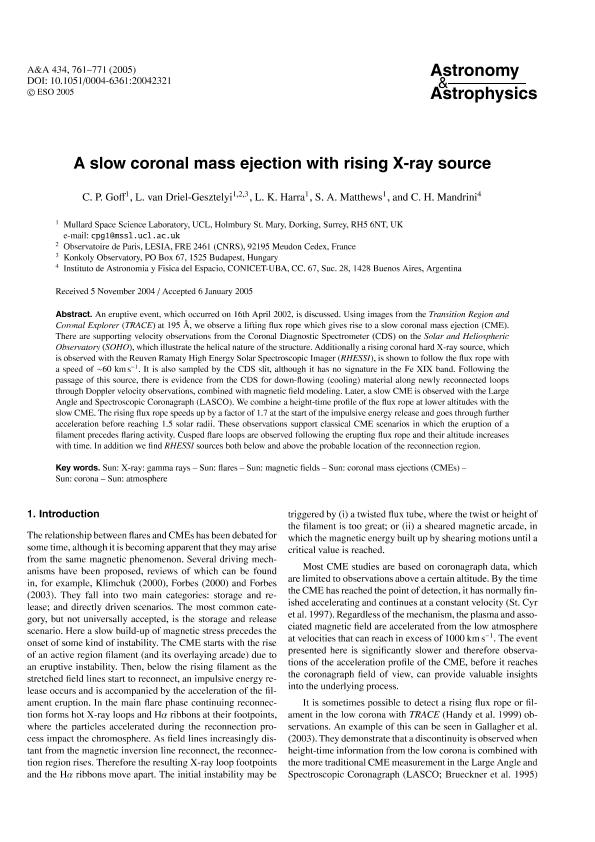Artículo
A slow coronal mass ejection with rising X-ray source
Fecha de publicación:
12/2005
Editorial:
EDP Sciences
Revista:
Astronomy and Astrophysics
ISSN:
0004-6361
Idioma:
Inglés
Tipo de recurso:
Artículo publicado
Clasificación temática:
Resumen
An eruptive event, which occurred on 16th April 2002, is discussed. Using images from the Transition Region and Coronal Explorer (TRACE) at 195 Å, we observe a lifting flux rope which gives rise to a slow coronal mass ejection (CME). There are supporting velocity observations from the Coronal Diagnostic Spectrometer (CDS) on the Solar and Heliospheric Observatory (SOHO), which illustrate the helical nature of the structure. Additionally a rising coronal hard X-ray source, which is observed with the Reuven Ramaty High Energy Solar Spectroscopic Imager (RHESSI), is shown to follow the flux rope with a speed of ~60 km s<sup>-1</sup>. It is also sampled by the CDS slit, although it has no signature in the Fe XIX band. Following the passage of this source, there is evidence from the CDS for down-flowing (cooling) material along newly reconnected loops through Doppler velocity observations, combined with magnetic field modeling. Later, a slow CME is observed with the Large Angle and Spectroscopic Coronagraph (LASCO). We combine a height-time profile of the flux rope at lower altitudes with the slow CME. The rising flux rope speeds up by a factor of 1.7 at the start of the impulsive energy release and goes through further acceleration before reaching 1.5 solar radii. These observations support classical CME scenarios in which the eruption of a filament precedes flaring activity. Cusped flare loops are observed following the erupting flux rope and their altitude increases with time. In addition we find RHESSI sources both below and above the probable location of the reconnection region.
Palabras clave:
Coronal Mass
Archivos asociados
Licencia
Identificadores
Colecciones
Articulos(IAFE)
Articulos de INST.DE ASTRONOMIA Y FISICA DEL ESPACIO(I)
Articulos de INST.DE ASTRONOMIA Y FISICA DEL ESPACIO(I)
Citación
Goff, C. P.; van Driel Gesztelyi, Lidia; Harra, L. K.; Matthews, S. A.; Mandrini, Cristina Hemilse; A slow coronal mass ejection with rising X-ray source; EDP Sciences; Astronomy and Astrophysics; 434; 2; 12-2005; 761-771
Compartir
Altmétricas




